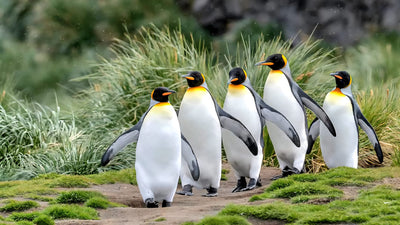World heritage sites - interesting information for geocachers too
World Heritage Site - also a worthwhile destination for geocachers, not only in Germany. A few days ago, Unesco decided again who will be allowed to bear the coveted title of World Heritage in the future. The pictures promise a lot...
Unesco awards the title world heritage (World Heritage and World Natural Heritage) at sites that are of world importance for their uniqueness, authenticity and integrity and are proposed for the title by the states in which they are located. (Wikipedia)
The title is based on the World Heritage Convention of 1972, which was ratified or accepted by 193 states and territories as of 2016. In 1978, the World Heritage List was started with the first twelve World Heritage sites. In Germany, the Imperial Cathedral in Aachen alone is one of the first 12 cultural heritage sites.
In the Federal Republic of Germany, the German federal states can independently apply for the nomination of a site as a UNESCO World Heritage Site.
In this post, we just want to show you a few World Heritage sites that may be of interest to geocachers. Many a German challenge aims to visit a certain number of World Heritage sites. We have already visited some world heritage sites worldwide with cacher trips. We were currently in the old town of Dubrovnik. This old town has been one of the cultural heritage sites of Europe since 1979. On the same trip we visited Mostar, which has two world heritage sites with its Stari Most and its old town. At least two cultural heritage sites are also on our route on our next big trip: the old town of Riga and the old town of St. Petersburg are also part of the world heritage sites. Whereas it is somewhat surprising that our next short trip does not include any world heritage sites, although Georgia, Azerbaijan and Armenia certainly have some natural monuments and cultural landscapes to offer. The David Gareja Monastery in Georgia on the border with Azerbaijan certainly deserves to be included as a World Heritage transnational cultural heritage...
Welterbestätte
UNESCO maintains a World Heritage List listing all World Heritage sites.

In 2017, the list includes 1073 sites in a total of 167 countries. Of these, 832 sites are World Heritage Sites and 206 are listed as World Natural Heritage. There are also a further 35 sites listed as mixed cultural and natural heritage sites. Of these, 37 sites are cross-border or transnational, i.e. they are assigned to two or more countries. On the Internet you can find many pictures that make you want to go on vacation.
Monuments are only included in the World Heritage List if they meet the criteria of “uniqueness” and “authenticity” (cultural landscape) or “integrity” (natural World Heritage) set out in the Convention and if a robust conservation plan is submitted.
The idea is that part or all of the cultural or natural heritage is of exceptional importance and worth preserving for future generations.
In Germany alone, 37 monuments of the cultural landscape belong to the World Heritage. In Berlin/Brandenburg, this includes the German Museum Island with its buildings, six modern housing estates and the large Berlin monument area around the German Sanssouci Palace. The Lorsch Monastery and Maulbronn Monastery also belong to the cultural heritage sites. All World Heritage sites in Germany can be found here: https://de.wikipedia.org/wiki/Welterbe_in_Deutschland
There are also numerous pictures here on Wiki that show the beauty of the places.
The Victoria Falls between Zimbabwe and Zambia make a well-known contribution to the world natural heritage transnationally – i.e. belonging to two states. Incidentally, Cacher-Reisen is planning a trip here in the next few years!
The other side of the coin
While the title of being a world cultural or natural heritage site certainly attracts many tourists, it also entails certain tasks for the respective state. Of course, the tourist attention is also associated with income. However, the strict requirements of the Commission are not easy to implement for every country and the attention of the tourist industry does not only lead to positive effects. We definitely see it in us cachers, e.g. also on cacher trips, that the world heritage sites in particular have a certain appeal and definitely steer our bus in the right direction. Not every footsteps left are positive for the corresponding region. It is all the more important that you take a close look at what specifications and what conditions are being made.
Rote Liste
UNESCO adds World Heritage Sites in Danger to its List of World Heritage in Danger. It is of secondary importance whether the admission is intended to send a signal to those responsible to make more effort to preserve the goods, or whether a state is asking for international support because it is overwhelmed with the protective measures itself. The aim of inclusion in the Red List is to draw up concrete catalogs of measures to restore the value that originally led to inclusion in the World Heritage List. This also applies to criteria such as preventing looting, art theft and conflict-related destruction (bombing, blasting, graffiti, etc.) and the creation of up-to-date inventory lists in museums, archives and cultural sites.

As of 2017, 54 World Heritage sites are on the Red List, including all World Heritage sites in Libya, Syria and the Palestinian Territories. No site on the list of German World Heritage Sites is currently endangered.
The Belize Barrier Reef is the longest barrier reef in the Northern Hemisphere and, with its protected components, illustrates the evolutionary history of reef development. It is also an important habitat for endangered species. The underwater world of Belize has been in bad shape for a long time. Oil drilling in the Central American country had endangered the coral reefs, animals were dying, colors were fading. The images were alarming. In 2009, UNESCO therefore put Belize's unique underwater world on the list of endangered world heritage sites.
The Belize World Heritage Site has recently been removed from the Red List. So today it is happily posted on various travel portals: There is hope: The second largest coral reef in the world is no longer endangered. Therefore, the entry on the “Vulnerable” list will be removed after nine years, Unesco said.
Various measures have led to this: In order to achieve the required criteria, Belize has:
- Declared a moratorium on oil drilling off its coast.
- Adopt strict rules for construction projects near the coast.
- Clearing of the mangrove forests newly regulated
Although Belize lost an important source of income because of the ban on oil production, the government has given tourism a higher priority. Belize Reef is the second largest reef in the world after Australia's Great Barrier Reef. It is also home to rare species such as the American sea crocodile, several endangered shark species, turtles and the rare manatee.
It's good that something has happened here. Last but not least, this is thanks to UNESCO.
The harshest punishment: banishment from the list
The last level of escalation at Unesco World Heritage occurs when – in the rarest of cases, namely only twice – places even get their status completely revoked.
Germany in particular is the second and so far last country in which a site was stripped of its World Heritage title.e The Dresden Elbe Valley was a World Heritage site from 2006 to 2009 and was then removed from the German list. As a consolation, only three other countries have more sites inscribed on the UNESCO World Heritage List.
Currently, the Uzbek world heritage site "Historical Center of Shahrisabz", which is located on the historic Silk Road, is threatened with withdrawal proceedings. Construction work has resulted in the exceptional value being considered lost. However, this week there was a compromise as many countries had collectively demanded a chance for Uzbekistan. A new report must now be submitted by next February. Let's hope that Uzbekistan manages to preserve the beauty and uniqueness of the world heritage - Cacher-Reisen is also planning a trip along the Silk Road! If you don't want to miss any information here, register quickly at https://www.cacher-reisen.com/de/Newsletter:_:14.html
World Heritage Day
The UNESCO World Heritage Day was launched in Germany in 2005. It takes place annually on the first Sunday in June with events at all World Heritage sites. In 2018, Aachen Cathedral was the center of World Heritage Day in Germany. Interesting pictures can also be found on the internet. The next World Heritage Day will take place on June 2, 2019.







Leave a comment